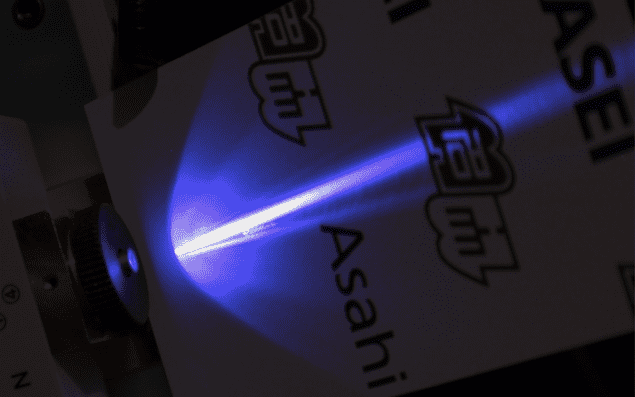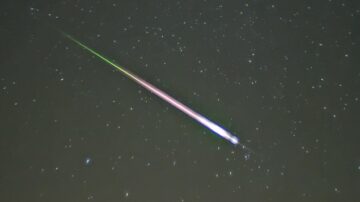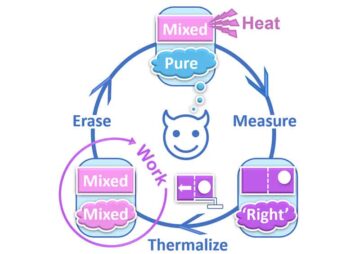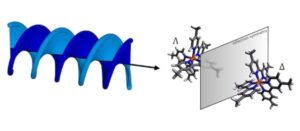
Researchers have succeeded in making the first room-temperature continuous-wave deep-UV laser diode, using wide-bandgap semiconductor materials. The device could find applications in novel sterilization systems and for more precise laser processing.
Invented in the 1960s, laser diodes today operate at wavelengths ranging from the infrared to blue-violet, with applications such as optical communications devices and Blu-ray discs. Until now, however, they did not work in the deep-UV part of the electromagnetic spectrum.
A team led by Nobel laureate Hiroshi Amano at Nagoya University’s Institute of Materials and Systems for Sustainability (IMaSS) began developing deep-UV laser diodes back in 2017, thanks to a collaboration with Asahi Kasei, the company that made the first 2-inch aluminium nitride substrates. These materials are ideal for growing aluminium gallium nitride (AlGaN) films for UV-light-emitting devices.
The first devices that the team made required input powers of 5.2 W, which was too high for continuous-wave lasing because it heated up the diode too quickly and stopped it from lasing.
In their new work, Amano and colleagues overcame this problem. By improving the design of the device structure, they could suppress the heat generated during operation. In particular, they eliminated the crystal defects that occur at the laser stripe in the AlGaN and deteriorate the paths through which current propagates. They achieved this by tailoring the side walls of the laser stripe such that current was able to efficiently flow to the active region of the laser diode. In this way, they could reduce the required operating power for 274 nm laser diodes to just 1.1 W at room temperature.

The blue solution
“Compared to conventional deep-ultraviolet lasers, our laser is more compact and can achieve higher efficiency,” says Amano. “The device could be employed in practical applications in healthcare, including virus detection. More broadly, it could be used to detect particulates, in gas analysis and high-definition laser processing.”
“Its application to sterilization technology could be ground-breaking,” adds team member Zhang Ziyi. “Unlike the current LED sterilization methods, which are time-inefficient, lasers can disinfect large areas in a short time and over long distances.”
The Nagoya team now plans to improve the operating characteristics of their laser diode for practical use. “We also hope to realize a shorter-wavelength laser diode,” Amano tells Physics World.
The study is detailed in Applied Physics Letters.
- SEO Powered Content & PR Distribution. Get Amplified Today.
- Platoblockchain. Web3 Metaverse Intelligence. Knowledge Amplified. Access Here.
- Source: https://physicsworld.com/a/defect-suppression-enables-continuous-wave-deep-uv-lasing-at-room-temperature/
- 1
- 2017
- 2022
- a
- Able
- AC
- Achieve
- achieved
- active
- Adds
- analysis
- and
- Application
- applications
- areas
- back
- because
- began
- Blue
- broadly
- characteristics
- collaboration
- colleagues
- COM
- Communications
- company
- conventional
- Copper
- Corp
- could
- Crystal
- Current
- demonstrated
- Design
- detailed
- Detection
- developing
- device
- Devices
- DID
- disinfect
- during
- efficiency
- efficiently
- eliminated
- enables
- films
- Find
- First
- flow
- from
- GAS
- generated
- ground-breaking
- Growing
- healthcare
- High
- high-definition
- higher
- hope
- However
- HTTPS
- ideal
- image
- improve
- improving
- in
- Including
- information
- input
- Institute
- issue
- IT
- large
- laser
- lasers
- Led
- Long
- made
- make
- Making
- materials
- max-width
- member
- methods
- more
- New
- Nobel Laureate
- novel
- operate
- operating
- operation
- part
- particular
- Physics
- plans
- plato
- Plato Data Intelligence
- PlatoData
- power
- powers
- Practical
- Practical Applications
- Problem
- processing
- quickly
- ranging
- realize
- reduce
- region
- required
- researchers
- Room
- semiconductor
- Short
- Spectrum
- stopped
- stripe
- structure
- Study
- Successfully
- such
- suppression
- Sustainability
- Systems
- team
- Technology
- tells
- The
- their
- Through
- thumbnail
- time
- to
- today
- too
- true
- university
- use
- virus
- W
- wavelengths
- which
- Wikipedia
- Work
- zephyrnet












